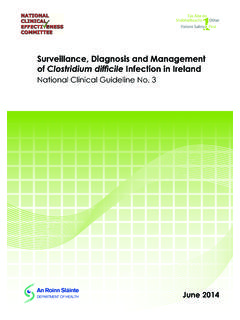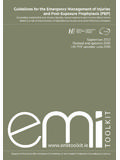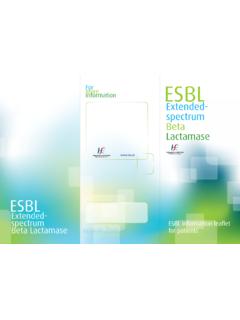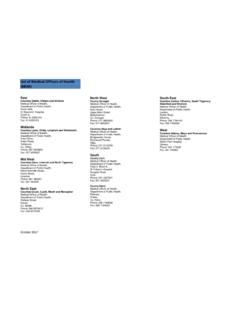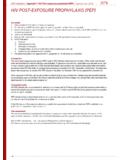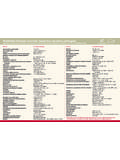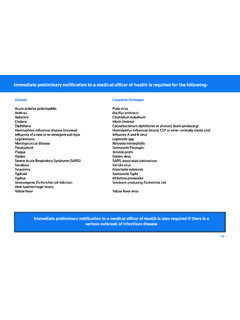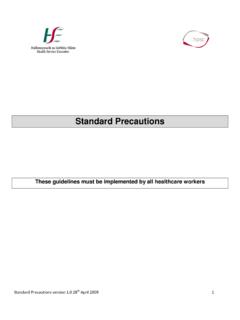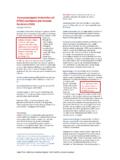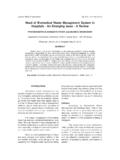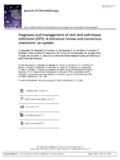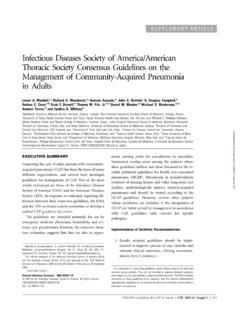Transcription of Health Protection Surveillance Centre
1 Health Protection Surveillance Centre Preschool and Childcare Facility Subcommittee management of infectious Disease in Childcare Facilities and Other Childcare Settings HSE management of infectious Disease in Childcare Facilities and Other Childcare Settings Table of Contents Foreword 3. Chapter 1. Introduction 9. Chapter 2: Infection 5. What is an infection? 5. How do infections spread? 5. Preventing the spread of infection 6. When should you contact your local Department of Public Health ? 7. Chapter 3: Infection Control 8. Standard precautions 8. Handwashing 8. Protective clothing 11. management of spillages of blood or other body fluids 12. management of cuts, nose bleeds, bites or needle-stick injuries 13. Respiratory hygiene and cough etiquette 14. Chapter 4: Immunisation 15. Childhood Immunisation 15. Immunisation Schedule 15. Chapter 5: Occupational Health 18. Pre-Employment Health Assessment 18.
2 Handwashing 19. Exclusion 19. infectious Diseases Relevant to Childcare Staff 19. Chapter 6: Environmental Hygiene 21. Hygiene and the Environment 21. Cleaning 21. Disinfection 23. Toys and educational/recreational materials and appliances 23. Outdoor water activities 24. Potty/toilet management 25. Nappy Hygiene 25. Waste management 26. Laundry 27. Chapter 7: Food hygiene 28. Infection control in the kitchen 29. Chapter 8: Animals and Infection Control 30. Pet hygiene 30. Farm and zoo visits 31. Chapter 9: management of specific infectious diseases 33. Chickenpox / Shingles 34. Conjunctivitis 34. Diphtheria 35. Campylobacter 35. -1- management of infectious Disease in Childcare Facilities and Other Childcare Settings HSE. Cryptosporidium 35. Salmonella 36. Shigella 36. Verocytotoxigenic (VTEC) 36. Norovirus 36. Outbreaks 37. Glandular Fever 37. Haemophilus influenza type b (Hib) 38. Hand, Foot and Mouth Disease 38.
3 Headlice 39. Hepatitis 39. Hepatitis A (Yellow Jaundice, infectious Hepatitis) 39. Hepatitis B 39. HIV/AIDS Infection 40. Impetigo 41. Influenza and Influenza-like Illness (Flu and ILI) 41. Measles 42. Meningitis (other than Meningococcal Meningitis) 42. Meningococcal Disease 43. Molluscum Contagiosum 43. Mumps 44. MRSA (Methicillin-Resistant Staphylococcus aureus) 45. Pharyngitis/Tonsillitis 45. Pneumococcus 45. Polio 46. Respiratory Syncytial Virus 46. Ringworm ( Tinea ) 47. Rubella (German measles) 47. Scabies 48. Scarlet Fever/Scarlatina 48. Slapped Cheek Syndrome/Fifth Disease (Parvovirus B19) 49. Tetanus 49. Tuberculosis (TB) 50. Typhoid and Paratyphoid 50. Verrucae (plantar warts) 51. Viral meningitis 51. Whooping Cough (Pertussis) 52. Worms 52. Acknowledgements 89. Appendices 55. Appendix A: Important Legislation Covering Childcare Facilities 56. Appendix B: National Working Group 57. Appendix C: Terms of Reference 58.
4 Appendix D: TB Assessment 59. Appendix E: Contact Details for Public Health Offices 60. Appendix F: Chlorine based Disinfectants 61. Appendix G: Guidelines for management of Suspected Outbreaks of Vomiting and/or Diarrhoea in Childcare Facilities 62. Appendix H: Design Requirements for a Childcare Facility 66. Appendix I: General Food Hygiene Requirements in Childcare Settings 69. Appendix J: Consultation process 70. Resources 71. -2- HSE management of infectious Disease in Childcare Facilities and Other Childcare Settings Foreword Given the extent to which we depend upon formal childcare arrangements in Ireland and the infectiousness of many childhood illnesses, there has never been a greater need for a simple, clear set of guidelines to assist those charged with minding our children in minimising the risk of infectious disease transmission in childcare facilities. This guidance document is based upon latest best evidence and drawn together by experts in the fields of Public Health Medicine, Infection Prevention and Control, Environmental Health and Occupational Medicine.
5 Important information regarding relevant legislation is laid out in Appendix A. The Terms of Reference of the Working Group are laid out in Appendix C. It is important to bear in mind that this document is a series of guidelines and a ready source of advice and is based on best available evidence and consensus recommendations; it is not designed to be a series of standards against which performance is to be audited. It is intended that this guidance would be adhered to as far as is reasonably practicable. In addition, there is a wealth of legislation governing the safe management of childcare facilities. It is the duty of managers of such facilities to ensure they are familiar, and compliant with all relevant legislation. It is hoped that this document will provide a useful resource for accessing legislation as it applies to managing the threat of infectious disease in childcare facilities. The opinion of the Subcommittee was that, where possible, childcare staff should be managed, from an occupational Health viewpoint, in the same manner as healthcare staff.
6 This, however, may not always be feasible, and so, at a minimum, childcare staff should be managed in a similar manner to staff in any other small-firm occupational setting. The Subcommittee was strongly of the opinion that childcare staff should ensure that they are adequately and appropriately immunised prior to commencement of employment. Likewise, as immunisation is such a powerful public Health preventive measure, all children attending a childcare facility should be appropriately immunised. I am extremely grateful for excellent and painstaking hard work and dedication of the Committee members who have produced this guidance. The Committee has produced an excellent and straightforward document, clear and accessible, and based on the best available evidence with a simple message: disease prevention in childcare settings is most likely to be successful if the following are ensured: 1. Effective handwashing is used at every opportunity 2.
7 All children and staff are appropriately immunised 3. Any unwell staff member or child is excluded. The aim of this document is to ensure that the basic principles of disease transmission and control are laid out in a clear and unambiguous way to assist in minimising the risk posed by infectious diseases in childcare settings. This document is laid out on the lines of, and based upon a previous draft document produced by the HSE South (Cork and Kerry) Childcare Guidelines Working Group in September 2007. I am deeply indebted to this Group for the work they have done and extremely grateful that they have allowed us to use their draft document as the basis for this document. From time to time, there will be additions and links to other resources that relate to the management of infectious diseases in childcare. This material will be made available on the HPSC website at Dr Paul McKeown (Chair). Preschool and Childcare Facility Subcommittee -3- management of infectious Disease in Childcare Facilities and Other Childcare Settings HSE.
8 Chapter 1. Introduction In a country such as Ireland, with a young population, and many households with two working parents, childcare has a pivotal role in helping to maintain our economy. It is in the interests of everyone to ensure that facilities providing childcare in loco parentis are operated in the safest and most effective manner possible. Infections are common in children and can occasionally result in illness in a child or outbreaks of illness in groups of children. When living at home, children will have contact with a limited number of people from whom they may contract an infection. When children are placed in a childcare1 setting they come into contact with far greater numbers of other children than might otherwise be possible, providing greater opportunity to be exposed to a range of infections. It will never be possible to prevent all infectious disease in children in childcare settings, but we know how to reduce appreciably the risk; strict observance of simple hygiene measures known as standard precautions, vaccination against certain diseases, and exclusion of symptomatic children and This guidance is intended to provide simple and effective strategies for prevention of infectious diseases in childcare and to be a reference source regarding the prevention and control of infection in pre-school childcare settings.
9 It is intended to be used by anyone operating childcare facilities in Ireland. Those who operate such facilities have a duty of care and the strategies outlined in this document will assist in protecting children and staff from infection and preventing onward transmission to families of children and staff. This guidance document builds on important guidance produced in the past. Guidance and information is available online on the management of a range of conditions and diseases including childhood vaccine preventable diseases, from the website of Health Protection Surveillance Centre at National guidance on the management of infectious disease in school children has been published by the Department of Health and There is a considerable body of legislation in this area. Legislation relevant to childcare and infectious diseases can be found in Appendix A. To facilitate accessing this legislation, it has been hyperlinked, largely to the relevant sections in the electronic Irish Statute Book, available at 1 A childcare facility is any childcare establishment that is covered by the Childcare (Pre School Services) ( ) Regulations 2006.
10 2 In a childcare setting standard precautions include adequate hand hygiene, use of protective clothing, proper laundry management , a clean environment, management of exposure to blood and body fluids and adequate washing and food storage and preparation equipment. 3 Department of Health and Children. Infection in School: A Manual for School Personnel. Health Promotion Unit, Dublin: 2006. -4- HSE management of infectious Disease in Childcare Facilities and Other Childcare Settings Chapter 2: Infection Children can spend long periods of time in childcare settings. The longer a child spends in such settings and the more children s/he comes into contact with, the greater is the risk of her/him becoming infected. As a result, it is never practicably possible to fully prevent all infection, but it is possible to reduce the risk substantially. Fortunately, there are a few simple strategies and activities that can go a long way towards preventing infection in childcare settings.
